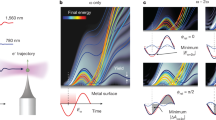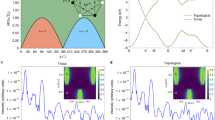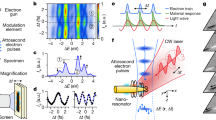Abstract
The strong fields associated with few-cycle pulses can drive highly nonlinear phenomena, allowing the direct control of electrons in condensed matter systems. In this context, by employing near-infrared single-cycle pulse pairs, we measure interferometric autocorrelations of the ultrafast currents induced by optical field emission at the nanogap of a single plasmonic nanocircuit. The dynamics of this ultrafast electron nanotransport depends on the precise temporal field profile of the optical driving pulse. Current autocorrelations are acquired with sub-femtosecond temporal resolution as a function of both pulse delay and absolute carrier-envelope phase. Quantitative modelling of the experiments enables us to monitor the spatiotemporal evolution of the electron density and currents induced in the system and to elucidate the physics underlying the electron transfer driven by strong optical fields in plasmonic gaps. Specifically, we clarify the interplay between the carrier-envelope phase of the driving pulse, plasmonic resonance and quiver motion.
This is a preview of subscription content, access via your institution
Access options
Access Nature and 54 other Nature Portfolio journals
Get Nature+, our best-value online-access subscription
$29.99 / 30 days
cancel any time
Subscribe to this journal
Receive 12 print issues and online access
$209.00 per year
only $17.42 per issue
Buy this article
- Purchase on Springer Link
- Instant access to full article PDF
Prices may be subject to local taxes which are calculated during checkout



Similar content being viewed by others
Data availability
The data that support the findings of this study are available from the corresponding author upon reasonable request.
Code availability
The code and algorithms that support the findings of this study are available from the corresponding author upon reasonable request.
References
Krauss, G. et al. Synthesis of a single cycle of light with compact erbium-doped fibre technology. Nat. Photon. 4, 33–36 (2010).
Herink, G., Solli, D., Gulde, M. & Ropers, C. Field-driven photoemission from nanostructures quenches the quiver motion. Nature 483, 190–193 (2012).
Dombi, P., Krausz, F. & Farkas, G. Ultrafast dynamics and carrier-envelope phase sensitivity of multiphoton photoemission from metal surfaces. J. Mod. Opt. 53, 163–172 (2006).
Krüger, M., Schenk, M. & Hommelhoff, P. Attosecond control of electrons emitted from a nanoscale metal tip. Nature 475, 78–81 (2011).
Schiffrin, A. et al. Optical-field-induced current in dielectrics. Nature 493, 70–74 (2012).
Piglosiewicz, B. et al. Carrier-envelope phase effects on the strong-field photoemission of electrons from metallic nanostructures. Nat. Photon. 8, 37–42 (2013).
Paasch-Colberg, T. et al. Solid-state light-phase detector. Nat. Photon. 8, 214–218 (2014).
Cocker, T. L. et al. An ultrafast terahertz scanning tunneling microscope. Nat. Photon. 7, 620–623 (2013).
Gao, C.-Z. et al. Strong-field effects in the photoemission spectrum of the C60 fullerene. Phys. Rev. A 93, 022506 (2016).
Echternkamp, K. E. et al. Strong-field photoemission in nanotip near-fields: from quiver to sub-cycle electron dynamics. Appl. Phys. B 122, 80 (2016).
Dombi, P. et al. Ultrafast strong-field photoemission from plasmonic nanoparticles. Nano Lett. 13, 674–678 (2013).
Cocker, T. L., Peller, D., Yu, P., Repp, J. & Huber, R. Tracking the ultrafast motion of a single molecule by femtosecond orbital imaging. Nature 539, 263–267 (2016).
Ahn, B. et al. Attosecond-controlled photoemission from metal nanowire tips in the few-electron regime. APL Photon. 2, 036104 (2017).
Vogelsang, J., Hergert, G., Wang, D., Groß, P. & Lienau, C. Observing charge separation in nanoantennas via ultrafast point-projection electron microscopy. Light Sci. Appl. 7, 4–11 (2018).
Jelic, V. et al. Ultrafast terahertz control of extreme tunnel currents through single atoms on a silicon surface. Nat. Phys. 13, 591–598 (2017).
Yoshioka, K. et al. Tailoring single-cycle near field in a tunnel junction with carrier-envelope phase-controlled terahertz electric fields. Nano Lett. 18, 5198–5204 (2018).
Yoshioka, K., Katayama, I., Minami, Y., Kitajima, M. & Yoshida, S. Real-space coherent manipulation of electrons in a single tunnel junction by single-cycle terahertz electric fields. Nat. Photon. 10, 762–765 (2016).
Rácz, P. et al. Measurement of nanoplasmonic field enhancement with ultrafast photoemission. Nano Lett. 17, 1181–1186 (2017).
Rybka, T. et al. Sub-cycle optical phase control of nanotunnelling in the single-electron regime. Nat. Photon. 10, 667–670 (2016).
Putnam, W. P., Hobbs, R. G., Keathley, P. D., Berggren, K. K. & Kärtner, F. X. Optical-field-controlled photoemission from plasmonic nanoparticles. Nat. Phys. 13, 335–339 (2017).
Savage, K. et al. Revealing the quantum regime in tunnelling plasmonics. Nature 491, 574–577 (2012).
Esteban, R. et al. A classical treatment of optical tunneling in plasmonic gaps: extending the quantum corrected model to practical situations. Faraday Discuss. 178, 151–183 (2015).
Wan, Y., Wubs, M. & Mortensen, N. A. Projected dipole model for quantum plasmonics. Phys. Rev. Lett. 115, 137403 (2015).
Zhu, W. et al. Quantum mechanical effects in plasmonic structures with subnanometre gaps. Nat. Commun. 7, 11495 (2016).
Hanke, T. et al. Tailoring spatiotemporal light confinement in single plasmonic nanoantennas. Nano Lett. 12, 992–996 (2012).
Aguirregabiria, G. et al. Dynamics of electron-emission currents in plasmonic gaps induced by strong fields. Faraday Discuss. 214, 147–157 (2019).
Brida, D., Krauss, G., Sell, A. & Leitenstorfer, A. Ultrabroadband Er:fiber lasers. Laser Photon. Rev. 8, 409–428 (2014).
Krauss, G. et al. All-passive phase locking of a compact Er:fiber laser system. Opt. Lett. 36, 540–542 (2011).
Marques, M. A. L. & Gross, E. K. U. Time-dependent density functional theory. Annu. Rev. Phys. Chem. 55, 427–455 (2004).
Krüger, M., Lemell, C., Wachter, G., Burgdörfer, J. & Hommelhoff, P. Attosecond physics phenomena at nanometric tips. J. Phys. B 51, 172001 (2018).
Lemell, C., Tong, X., Krausz, F. & Burgdörfer, J. Electron emission from metal surfaces by ultrashort pulses: determination of the carrier-envelope phase. Phys. Rev. Lett. 90, 076403 (2003).
Wachter, G. et al. Electron rescattering at metal nanotips induced by ultrashort laser pulses. Phys. Rev. B 86, 035402 (2012).
Schuck, P. J., Fromm, D. P., Sundaramurthy, A., Kino, G. S. & Moerner, W. E. Improving the mismatch between light and nanoscale objects with gold bowtie nanoantennas. Phys. Rev. Lett. 94, 017402 (2005).
Dombi, P. et al. Observation of few-cycle, strong-field phenomena in surface plasmon fields. Opt. Express 23, 24206–24212 (2010).
Birge, J. R., Ell, R. & Kärtner, F. X. Two-dimensional spectral shearing interferometry for few-cycle pulse characterization. Opt. Lett. 31, 2063–2065 (2006).
Gunnarsson, O. & Lundqvist, B. I. Exchange and correlation in atoms, molecules, and solids by the spin-density-functional formalism. Phys. Rev. B 13, 4274–4298 (1976).
Lang, N. D. & Kohn, W. Theory of metal surfaces: work function. Phys. Rev. B 3, 1215–1223 (1971).
Nguyen, H. S., Bandrauk, A. D. & Ullrich, C. A. Asymmetry of above-threshold ionization of metal clusters in two-color laser fields: a time-dependent density-functional study. Phys. Rev. A 69, 063415 (2004).
Zuloaga, J., Prodan, E. & Nordlander, P. Quantum plasmonics: optical properties and tunability of metallic nanorods. ACS Nano 4, 5269–5276 (2010).
Acknowledgements
D.B. and A.L. acknowledge support of the Deutsche Forschungsgemeinschaft through the Emmy Noether programme (BR 5030/1-1) and the collaborative research centre SFB 767. D.B. acknowledges support from the European Research Council through grant no. 819871 (UpTEMPO). G.A. acknowledges project PI2017-30 of the Departmento de Educación, Política Lingüística y Cultura of the Basque Government, and G.A. and J.A. acknowledge funding from project FIS2016-80174-P of the Spanish Ministry of Science, Innovation and Universities MICINN, as well as grant IT1164-19 for consolidated university groups of the Basque Government.
Author information
Authors and Affiliations
Contributions
J.A., A.G.B., A.L. and D.B. conceived the project. A.L. and D.B. supervised the experimental activity. M.L., F.R. and T.R. fabricated the nanostructures, developed the set-up and performed the measurements. J.A. and A.G.B. coordinated the theoretical modelling. G.A., D.C.M. and A.G.B. developed the theory simulations. All authors contributed to the discussion of the data and to writing the manuscript.
Corresponding author
Ethics declarations
Competing interests
The authors declare no competing interests.
Additional information
Peer review statement Nature Physics thanks Christian Nijhuis, Olga Smirnova and the other, anonymous, reviewer(s) for their contribution to the peer review of this work.
Publisher’s note Springer Nature remains neutral with regard to jurisdictional claims in published maps and institutional affiliations.
Supplementary information
Supplementary Information
Supplementary discussion with Supplementary Figs. 1–14.
Source data
Source Data Fig. 1
Zip archive with the files (txt) of the data plotted in Fig. 1.
Source Data Fig. 2
Zip archive with the files (txt) of the data plotted in Fig. 2.
Source Data Fig. 3
Zip archive with the files (txt) of the data plotted in Fig. 3.
Rights and permissions
About this article
Cite this article
Ludwig, M., Aguirregabiria, G., Ritzkowsky, F. et al. Sub-femtosecond electron transport in a nanoscale gap. Nat. Phys. 16, 341–345 (2020). https://doi.org/10.1038/s41567-019-0745-8
Received:
Accepted:
Published:
Issue Date:
DOI: https://doi.org/10.1038/s41567-019-0745-8
This article is cited by
-
Sub-cycle multidimensional spectroscopy of strongly correlated materials
Nature Photonics (2024)
-
Real-time tracking of coherent oscillations of electrons in a nanodevice by photo-assisted tunnelling
Nature Communications (2024)
-
Tracing attosecond electron emission from a nanometric metal tip
Nature (2023)
-
Few-femtosecond phase-sensitive detection of infrared electric fields with a third-order nonlinearity
Communications Physics (2023)
-
Attosecond electron microscopy of sub-cycle optical dynamics
Nature (2023)



